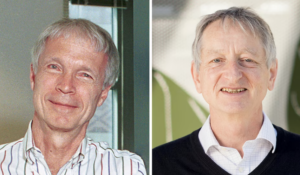The 2024 Nobel Prize in Physics has been awarded to two trailblazers in the field of machine learning, John Hopfield and Geoffrey Hinton. Their groundbreaking research has not only revolutionized the field of artificial intelligence but also laid the foundation for innovations across numerous industries. This recognition by the Nobel Committee underscores the critical impact of machine learning technologies on modern science and society.

The Extraordinary Contributions of John Hopfield
John Hopfield is celebrated for introducing the Hopfield Network in 1982, a key development in neural networks that sparked a new era of computational biology and artificial intelligence. The Hopfield Network provided a concrete model on how artificial neural networks could mimic the function and processes of biological brains. Hopfield Networks are capable of storing memories and resolving conflicts through a process analogous to collective computation—an insight that was revolutionary at the time.
- Energy-based models: The Hopfield Network is based on an energy function that drives the system towards stable states, much like neurons finding equilibrium.
- Associative memory: These networks can retrieve complete memories based on partial input data, akin to how humans recognize familiar faces from partial or distorted images.
- Inspiration for modern AI: Hopfield’s work has inspired subsequent developments such as Deep Learning which underpins today’s AI systems.
Hopfield’s innovations have gone beyond theoretical implications, playing critical roles in practical fields like data optimization, pattern recognition, and even finance.
Geoffrey Hinton: A Heart of Deep Learning
Geoffrey Hinton, often dubbed the “Godfather of Deep Learning”, has made seminal contributions that have brought machine learning to the forefront of technological advancement. With his work on the backpropagation algorithm, Hinton paved the way for neural networks to learn more efficiently and effectively. His developments have been pivotal in the advent of complex AI applications that are part of our daily lives.
- Backpropagation Algorithm: A method that enables neural networks to automatically correct errors and improve accuracy, forming the backbone of deep learning.
- Convolutional Neural Networks (CNNs): Foundational to image and speech recognition technologies, revolutionizing fields like medical imaging and autonomous vehicles.
- Theoretical and Practical Impacts: Hinton’s innovation has bolstered research in understanding cognitive functions and designing efficient algorithms that mimic human learning capacities.
Hinton’s influence extends into applied sciences, with contributions that power systems behind natural language processing, image classification, and speech recognition. These advancements are central to technology giants like Google and Facebook, showcasing the indispensable nature of his research.
The Global Impact of Machine-Learning Innovations
The Nobel Prize awarded to both Hopfield and Hinton is not just a nod to individual achievements but highlights the transformative impact of machine learning on a global scale. These innovations have driven substantial technological shifts and improvements across sectors beyond traditional AI applications.
Advancements in Healthcare
Machine learning is at the heart of healthcare innovations, revolutionizing the way we diagnose, treat, and manage diseases. AI-powered tools have empowered practitioners with advanced diagnostics and personalized treatment plans. Key applications include:
- Predictive analytics: Identifying patterns and predicting patient outcomes with greater accuracy.
- Medical imaging: Enhancing accuracy in detecting anomalies such as tumors in images taken from MRI and CT scans.
- Drug Discovery: Rapid identification of potential drug candidates through large data set analyses.
Economic and Industrial Implications
The ripple effects of AI innovations have had significant economic and industrial implications:
- Automation: Increasing efficiencies and reducing costs in manufacturing and supply chain management.
- Finance: Algorithmic trading, risk management, and fraud detection powered by machine learning models.
- Energy Management: Optimizing energy consumption and facilitating the transition to renewable energies.
The Future of AI and Scientific Exploration
The achievements of Hopfield and Hinton are reminders of the vast potential machine learning holds for future scientific exploration and application. As AI continues to evolve, it offers an opportunity to solve some of humanity’s most pressing challenges, from climate change to global health crises.
Educators, policymakers, and industry leaders are keenly aware of the need to foster environments conducive to continued innovation in this field. The push comes both from grassroots innovators and established research institutions—ensuring AI remains ethically deployed and aligned with global betterment.
As we celebrate the Nobel achievements of Hopfield and Hinton, we simultaneously anticipate a future enriched by their legacies. Their work has not only entertained the scientific community but has enriched human lives by making the impossible, possible.
By recognizing the contributions of these visionary scientists, the Nobel Committee has affirmed the pivotal role that machine learning will continue to play in shaping the future, driven by the curiosity and perseverance of pioneers like Hopfield and Hinton.
“`
This blog post aims to provide comprehensive insights into the achievements of John Hopfield and Geoffrey Hinton, emphasizing their profound impact on the evolution of machine learning and its real-world applications.
